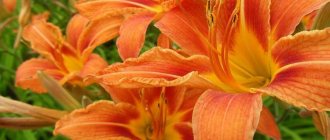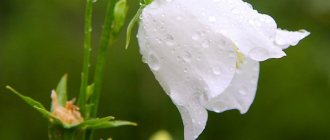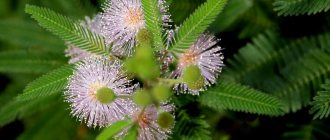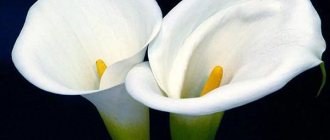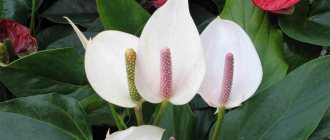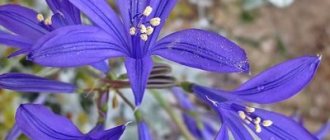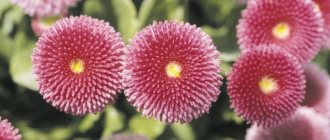Description with photos of plants with paniculate inflorescences similar to mimosa
All plants that resemble mimosa are united by their characteristic flowering with paniculate inflorescences. Each of them consists of many small flowers with long stamens. These inflorescences give plants lightness and airiness.
goldenrod
Canadian goldenrod (or solidago) is a herbaceous rhizomatous perennial that is often called the “northern mimosa.” This plant is so unpretentious that it can grow in any climate and any conditions. In the wild it grows in a field, under the scorching rays of the sun. Goldenrod easily tolerates severe frosts, so it can be grown even in Siberia.
[adsp-pro-4]
The height of the goldenrod stem is from 40 centimeters to 2 meters. The erect stems are densely leafy, with alternately placed pointed, lanceolate-shaped leaves. Goldenrod begins to bloom in its second year. The plant forms paniculate inflorescences, which consist of small buds of bright yellow color.
Lonas
Annual lonas, often called golden ageratum, produces dense inflorescences of corymbs that look like fluffy mimosa. The plant is bushy, with stiff branches. The lonas bush grows up to 50 centimeters. The leaves of the plant are alternate, deeply cut, elongated. Each shoot ends in an inflorescence. Lonas blooms for a long time, from July to the end of autumn.
In the wild, lonas grows in Southern Italy, Sicily, and North-West Africa. The plant remains decorative when cut and dried, so it is often used in winter flower arrangements.
Forsythia
Forsythia is a tall shrub that leaves no one indifferent during flowering. The branches of the plant are densely covered with small, bright yellow, bell-shaped flowers.
Forsythia is native to eastern Asia and southeastern Europe. In central Russia, the bush blooms at the end of April and beginning of May. Moreover, the peculiarity of the plant is that the flowers bloom before the foliage. In early spring, cut branches bloom in a vase and last for about 2 weeks.
Mahonia
Mahonia is an evergreen shrub about 150 centimeters high, with leathery, sharp-toothed leaves along the edge. In May, at the end of the shoots, the bush forms numerous paniculate inflorescences of yellow color. Mahonia blooms in waves, repeating itself in October. Each flowering period lasts about 30 days.
[adsp-pro-5]
Mahonia's homeland is North America, where it grows in forests and overgrown slopes. In cultivated plant growing, the shrub is widely used in the design of garden plots and looks great as a hedge.
Meadowsweet
Meadowsweet (meadowsweet) is a perennial shrub with a height of 50 to 180 centimeters, with paniculate inflorescences. Meadowsweet flowers are cream or white, but the shape of the inflorescence resembles a mimosa bloom.
The first flowers on meadowsweet bushes appear in early June. The total flowering period is 2 months. The red meadowsweet looks spectacular during flowering, resembling a bright, airy cloud from afar.
Meadowsweet is widespread in the nature of Europe, Asia Minor and Central Asia, Kazakhstan, the Caucasus, Siberia and Mongolia. The shrub prefers damp areas, so it settles along the banks of rivers, lakes, in grassy areas of swamps, and in damp forests.
Albizia
Albizia is a genus of tropical deciduous shrubs with spherical inflorescences characteristic of mimosa. Due to the similarity of flowering, Albizia is often called mimosa. Albizia flowers are yellowish-white or pink in color and covered with long silky needles.
Albizia blooms from mid to late summer. This plant has conquered almost the entire world as a park ornamental shrub. In our country, it is cultivated mainly in the southern regions. It is especially numerous in Kerch, where city alleys and squares are decorated with it.
Skumpia
Mackerel is a branched deciduous shrub of the sumac family, reaching a height of 3 meters. The homeland of skumpia is Asia, Europe and North America. In our country, the plant is distributed mainly in the Caucasus and Crimea.
[adsp-pro-7]
The main advantage of skumpia is the greenish-yellow paniculate inflorescences that cover the bush in June-July. The bush becomes especially bright and beautiful during the fruiting period, when long gray-violet, pink or purple hairs appear on the flowers.
Fieldfare
Fieldfare is a tall shrub native to Asia, Siberia and the Far East. The plant is highly decorative. Thanks to the leaves. Similar in shape to rowan. The leaves are bright green when they begin to bloom, and in the fall they turn golden or bright orange.
The fluffy paniculate inflorescences in the shape of elongated pyramids give the fieldfare a resemblance to mimosa. During flowering, yellowish-white or beige panicles cover almost the entire bush.
Smilacina racemosus
A plant from deciduous forests in southern Canada and eastern America. It is a low-growing perennial with elongated or oval, large leaves. Smilacina stems are from 30 to 90 centimeters in height.
During flowering, sparse, oblong panicles of a white-yellow or purple-pink hue are formed at the top of the stems. The shape of the inflorescences and the stamens clearly protruding from the flowers give smilacina a resemblance to mimosa.
Flowers. Plants. An interesting plant is Solidago canadensis (Goldenrod).
Show description Flowers. Plants. An interesting plant: Solidago canadensis. This beautiful perennial is popularly called “northern mimosa” for the similarity of the flowers, and also Goldenrod.. My channel is about bearded irises and all the plants that grow around us.. My website (online store) https://irisy-tv. com.ua/. My second channel: https://www.youtube.com/channel/UCe4OPIZTKagqP8wCAsNvWxQ. Odnoklassniki https://ok.ru/profile/449300090435. Facebook https://www.facebook.com/profile.php?id=100009210151978. VKontakte https://vk.com/id143431976
Video taken from channel: Talla H. Flowers
Botanical description and origin of Hamedorea
Hamedorea, or bamboo palm, is a monocotyledonous flowering plant widely distributed in South and Central America. Under natural conditions, it usually does not grow more than 2 m. Some varieties of low-growing shrubs, due to their unpretentiousness, are cultivated as indoor plants, turning a standard interior into a real oasis.
The trunk of the bush palm is thin, so several plants are grown in a pot. Thanks to this technique, the effect of palm thickets is achieved, since the long leaves (up to 40 cm) with wide segments have an openwork pinnate shape. The plant produces 2–3 new leaves per year. In indoor culture, the height of adult bushes is limited to 1 - 1.5 m.
Unlike leaves, flowers do not represent any decorative value. The palm tree blooms like a mimosa, and its flowering is not tied to a specific time of year. They can appear at any time.
What is the difference between mimosa and silver acacia
Let's start with the fact that mimosa is a small herbaceous shrub with climbing shoots. This is a true tropical plant that does not grow in our open ground. Mimosa is grown mainly in greenhouses and at home. In the latter case, mimosa pudica is most often planted. It grows as an annual due to its capricious nature and high requirements for living conditions.
The bashful mimosa has one more characteristic difference: it “lives its own life.” The leaves do not like to be touched and close.
Acacia grows in the form of a tree, the average height of which is 12 m. In natural conditions, larger specimens up to 45 m tall are also found. Acacia also loves warmth and has low frost resistance, but not as much as mimosa.
Silver acacia grows mainly on the Black Sea coast. It blooms early, already at the end of spring, and in warm southern climates even in the middle of winter. But real mimosa blooms much later, from May to September.
You can even distinguish a mimosa sprig from an acacia tree by the following characteristics:
- the feathery leaves of the acacia are covered with a light silvery tint, which gave the culture its name;
- mimosa has smaller, green foliage;
- mimosa flowers are lilac, and only acacia flowers are yellow;
- Also, the fluffy mimosa balls are slightly larger than the yellow acacia pompoms, and the inflorescence itself is not so lush.
Given the difference in size, mimosa fruits are also several times smaller than acacia pods. But be that as it may, both plants are charming in their own way. If climatic conditions permit, you can plant an acacia tree in the garden, and let a mimosa grow in a pot on the windowsill. Then you can admire their blooms one by one and almost all year round.
Origin
The homeland of mimosa (or silver acacia) is Australia (its southeast coast) and the island of Tasmania.
From there, this shrub gradually began to appear in the warm regions of the European and African continents, and in the United States. In our country, it has taken root on the Black Sea coast - mainly in the republics of Transcaucasia. Mimosa has been growing there for almost two centuries. The photographs show how beautiful the yellow balls of mimosa flowers look on bushes growing in natural conditions.
Homeland of mimosa
Mimosa
True mimosa is a genus of flowering plants in the legume family, subfamily Mimosa. For the most part, these are low trees and shrubs with bright green feathery leaves, dense ball-inflorescences and bean-like fruits. The habitat of the vast majority of mimosas is South America and Australia.
The most popular plant of this subfamily, Mimosa pudica, comes from South America. In the wild, it is a herbaceous perennial up to 1 m high with spiny stems and delicate bipinnate “lacey” leaves.
Due to the characteristics of the foliage, this mimosa got its name - in response to the lightest touch, the leaves curl and droop. This is due to the fact that there are water membranes at the base of the petioles, and there are sensory areas on the leaves that respond to pressure. Upon contact, water moves to this place, and under its weight the leaves “fold”.
But mimosa flowers are not yellow at all, but lilac-pink, collected in spherical inflorescences. The plant is pollinated by wind and insects, in our latitudes it is cultivated as an excellent ornamental plant for rooms and greenhouses, blooming from May to September.
All parts of the plant are poisonous!
Plants produce seeds already in the first year of vegetation, therefore, to maintain decorative properties in apartments, it is bred mainly as an annual.
Diseases and pests
The main enemies of mimosa are gray rot, rust, and fungus. Most often they occur due to improper care.
For preventive purposes, the plant should be periodically carefully inspected for the presence of black or rusty spots, mucus, and small insects (aphids, spider mites) on the stems or leaves.
There are many ways to combat mimosa diseases. Including traditional methods:
- treating the plant with a solution of potassium permanganate;
- furatsilina;
- water and laundry soap.
Treatment with any insecticidal preparation will be more effective. Repeat treatment after a week
Mimosa Hostilis (Hostilis) aka Mimosa Tenuiflora - what kind of flower is it
Mimosa Hostilis and the flower that is traditionally given to women on March 8 in Russia are not the same thing. After the dissolution of the Mimosa family, some confusion occurred, and throughout the world the second plant was classified as a member of the Acacia family. Therefore, it is not surprising that Hostilis is very different in appearance from the usual mimosas.
Mimosa Hostilis
Brief description of what it looks like
In the wild, the height of the tree can reach 8 meters, but this is in rare cases. Most often you can find small shrubs with a woody trunk. Some specimens have spines about 4 mm long at the base.
White fragrant inflorescences are spikelets. Hostilis has fruits in the form of pods divided into several parts. Inside are small dark-colored seeds in a hard shell. The pod can reach 3 cm in length. The leaves of the plant are dissected, pinnate, about 5 cm long.
Where does it grow in the wild?
In the wild, Hostilis is most common in Brazil. The largest numbers are observed in the northeastern states, including:
- Rio Grande do Norte;
- Ceara;
- Bahia;
- Pernambuco;
- Paraiba.
Individual specimens were also found on the coast of Chiapas and Oaxaca, which is the southern part of Mexico, and these are even more northern areas. The optimal growing environment is from the ninth and higher frost resistance zones (geographically defined zones based on the principle of the average annual minimum temperature). Hostilis grows at high elevations; rare specimens are found at an altitude of about 1 km.
Mimosa flowers
Where you can see mimosa blooming in Abkhazia
The largest plantations of silver acacia are located near the Russian-Abkhaz border. During the flowering period, the entire surrounding area turns yellow.
Border areas are not the only place where Abkhazian mimosa grows. The republic even conducts excursion tours to the places where it blooms; they include visits to Sukhum, Gagra and New Athos.
Mimosa is easy to care for and can grow up to 12 meters in height.
Many Russian vacationers take with them from Abkhazia not only mimosa flowers, but also cuttings and seeds. The unpretentious acacia is successfully taking root, expanding the geography of its habitat.
Ivan-tea: how not to be confused with poisonous weeds. (Russian tea).
Show description Canadian goldenrod is very similar to fireweed. Ecologists warn: in terms of the degree of danger to the environment and human well-being, this alien species is on a par with hogweed and the Colorado potato beetle.. Read in full: https://news.tut.by/society/355008.html. The plant is poisonous and can only be used in recommended doses. Decoctions and infusions should not be used by pregnant and breastfeeding women. Such infusions are prohibited for patients with acute glomerulonephritis. Some people may have an allergic reaction to this plant https://polzaverd.ru/griby/zolotarnik-poleznye-svojstva.html. Poisonous plants are companions of angustifolia fireweed. Even when manually collecting Ivan tea, from which Koporye tea will be made, you need to be very careful. Especially in the early growing season. Otherwise, the aroma and taste of the drink may be distorted. Serious poisoning is also possible.. The pursuit of quantity always reduces quality.. Take care of yourself and your children! The golden cane is very similar to the Cyprian. Environmentalists warn of the hazard to the environment and human well-being, this alien species is on a par with parsnip and potato Colorado beetle.. Read more: https://news.tut.by/society/355008.html. The plant is poisonous and can only be used at recommended doses. Broths and infusions can not be applied to pregnant and breastfeeding women. Such infusions are forbidden to patients with acute glomerulonephritis. Some people may develop an allergic reaction to this plant https://polzaverd.ru/griby/zolotarnik-poleznye-svojstva.html. Poisonous plants are the companions of the angustifoliae.. Even with the manual collection of Ivan-tea, from which Kopor tea will be made, one must be very careful. Especially in the initial period of vegetation. Otherwise, the aroma and taste of the beverage may be distorted. Not excluded and serious poisoning.. Pursuit of quantity always reduces the quality.. Take care of yourself and your children!
Video taken from channel: Alexander Vyazemsky
Salad "MIMOSA" classic recipe, very tasty and flaky
Show description #mimosa salad#recipe. The most delicious quick MIMOSA salad, this salad will decorate your holiday table and is very easy and simple to prepare. Ingredients. Boiled potatoes 2 pcs. Mayonnaise each layer. Sprat or saury 1ban. Onion 1 pc. Boiled carrots - 2 pcs. Boiled eggs - 4 pcs. Greenery. = The most delicious quick MIMOSA salad, this salad will decorate your holiday table and is prepared very easily. Ingredients. Potatoes boiled 2pcs. Mayonnaise each layer. Sprat 1ban. Onion 1pc. Carrots boiled -2pcs. Boiled eggs-4pcs. Green. ✔✔✔✔✔✔✔✔✔✔✔✔✔✔✔✔✔. #mimosa salad #homemade rolls #chicken salad #quick dinner #cottage cheese buns #biscuit #chocolate biscuit #lamb shurpa #delicious breakfast #quick breakfast #puff bun #cheese soup #baked goods #pies #buns #cakes #delicious dinner #quick breakfast #healthy lunch #dough #homemade food #delicious chicken#homemadecakes#foodanytaste#salads #snacks#fast food. My playlists. Delicious pastries. https://www.youtube.com/playlist?list=PLlXuSshk4EWB4I6qsKRB7as5X4E067Uiv. = Delicious and light salads. https://www.youtube.com/playlist?list=PLlXuSshk4EWAcOXeL1AExQ8ilKGklDF4f. ÷÷÷÷÷÷÷÷÷÷÷÷÷÷÷÷÷÷÷÷÷÷÷÷÷÷÷÷÷÷. Food for every taste. https://www.youtube.com/playlist?list=PLlXuSshk4EWDHqL01KAikBgSoecuCfe5x
Video taken from channel: Tajik food
What do plants have in common?
First of all, both crops are members of the legume family and belong to the mimosa subfamily. Most likely, this was the reason that in our area acacia is known as mimosa.
However, this is not the only thing that unites them:
- Both mimosa and acacia have almost the same leaf structure. It is doubly feathery, similar to a bird's feather. Each narrow leaf is covered with small hairs.
- The structure of the flowers is also similar. Each one looks like a fluffy little ball and is made up of many stamens. The modest-sized flowers are collected in inflorescences, forming a lush panicle.
- Since both plants are from the legume family, they bear fruit in pods containing bean seeds.
WHAT FLOWER ARE YOU ACCORDING TO YOUR ZODIAC SIGN?
Show description Flowers, herbs, plants and trees are ruled by the signs of the Zodiac. For each sign, there are flowers and plants that bring good luck and love according to their zodiac influences. Knowing these astrological patterns will come in handy if you want to give flowers as a sign of love and respect. If you love indoor flowers, give preference to those that match your zodiac sign, they will help create an atmosphere of harmony and well-being in your home.. 00:40 Aries. 02:17 Taurus. 03:41 Gemini. 05:05 Cancer. 06:09 Lev. 07:44 Virgo. 09:27 Libra. 11:04 Scorpio. 12:12 Sagittarius. 13:22 Capricorn. 14:24 Aquarius. 15:05 Pisces
Video taken from the channel: FOLK SIGNS
Transfer
The flower is mainly grown as an annual. But there are exceptions to the rules, and a transplant may be necessary. The main rule when replanting is not to damage the integrity of the root system.
Experienced gardeners advise saving the mimosa seeds that form in the plant's pods and using them to grow a new plant. A photo of a mimosa flower is presented below.
Location
Growing mimosa pudica at home is not too difficult. This plant is usually grown at home due to its unusual reaction to touch - for entertainment. But if you constantly touch the leaves of a mimosa so that it curls them, this will lead to the fact that the plant will run out of energy, and the mimosa will simply die.
Mimosa in a pot
But it is better not to keep blooming mimosa at home if there are people in the family who suffer from an allergic reaction to pollen from flowers and plants. After all, mimosa blooms for a couple of months, and all this time pollen particles will be in the air.
The plant loves sunlight very much, so it needs to be placed in windows where there will be sun for at least half a day.
It is better to place mimosa on a south-east or south-west window, where the sun comes either in the morning or in the evening. In winter, this plant lacks lighting, and if it is not provided with additional lighting, the mimosa will begin to grow upward and stretch out too much. In this case, in the spring the mimosa is cut short enough to give the bushes a compact shape.
Flowering time
The peculiarity of the Abkhazian mimosa is that it blooms in winter (around mid-January) and gradually stops flowering with the arrival of spring.
This feature allows local residents to make mass cuttings of flowers for sale in Russia for International Women's Day. This usually happens at the end of February; in the warmest winters, mimosa in Abkhazia is cut before the New Year.
A high degree of adaptation allows mimosa to be grown in other warm places.
